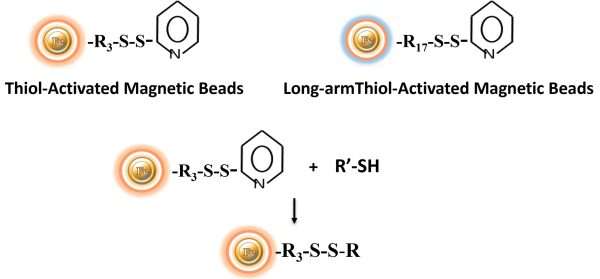
These chemicals can be used to crosslink proteins and introduce sulfhydryl groups. Pyridyl disulfides form disulfide connections with sulfhydryl groups over a wide pH range (the optimum is pH 4 to 5). A disulfide exchange happens during the reaction between the molecule’s -SH group and the reagent’s 2-pyridyldithiol group. The disulfide exchange can be conducted at physiological pH. However, the reaction rate is slower.
Applications for pyridyl disulfide immobilization
Because pyridyldithiol compounds generate disulfide bonds with target sulfhydryls, conjugates created with these crosslinkers are cleavable using common disulfide reducing agents, such as dithiothreitol (DTT) or sample buffer for protein electrophoresis (SDS-PAGE). Thus, pyridyldisulfide magnetic beads are useful alternatives to maleimide and haloacetyl reagents when it is necessary to reverse the sulfhydryl-conjugation step later in an experimental procedure (i.e., to exactly recover the original sulfhydryl-containing molecule).
BcMagTM Thiol-activated Magnetic Beads are uniform magnetic beads coated with high-density thiol functional groups (2-pyridyl disulfide) on the surface (Fig.1). The beads can reversibly immobilize thiol-containing ligands under mild conditions. After affinity purification, reducing agents such as DTT or β-mercaptoethanol can cleave and separate the target molecule-ligand complex from the beads. BcMag™ thiol-activated magnetic beads are most suitable for the conjugation of large proteins. BcMag™ long-arm thiol-activated Magnetic Beads are recommended to conjugate small peptides because the long-arm hydrophilic linker may reduce steric hindrance.

Workflow
The magnetic matrix works perfectly as affinity resin for a wide variety of affinity purification to refine thiol group-containing proteins or other molecules from the sample. After washing away unbound material, the thiol-containing substance is eluted by the addition of a reducing agent such as DTT or 2-mercaptoethanol.

Features and Advantages
●
Pre-activated and ready-to-use
●
A cleavable built-in disulfide bond allows the ligand-target molecule complex separated from the beads
●
Specific isolation of cysteine proteins/peptides
●
Stable covalent bond with minimal ligand leakage
●
Produces reusable affinity matrix
●
Low nonspecific binding
●
Applications: Affinity purification, immunoprecipitation, purification of antibodies, proteins/peptides, DNA/RNA
Learn More
Instruction Manual
MSDS
Related Affinity Magnetic Beads →


